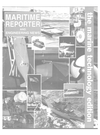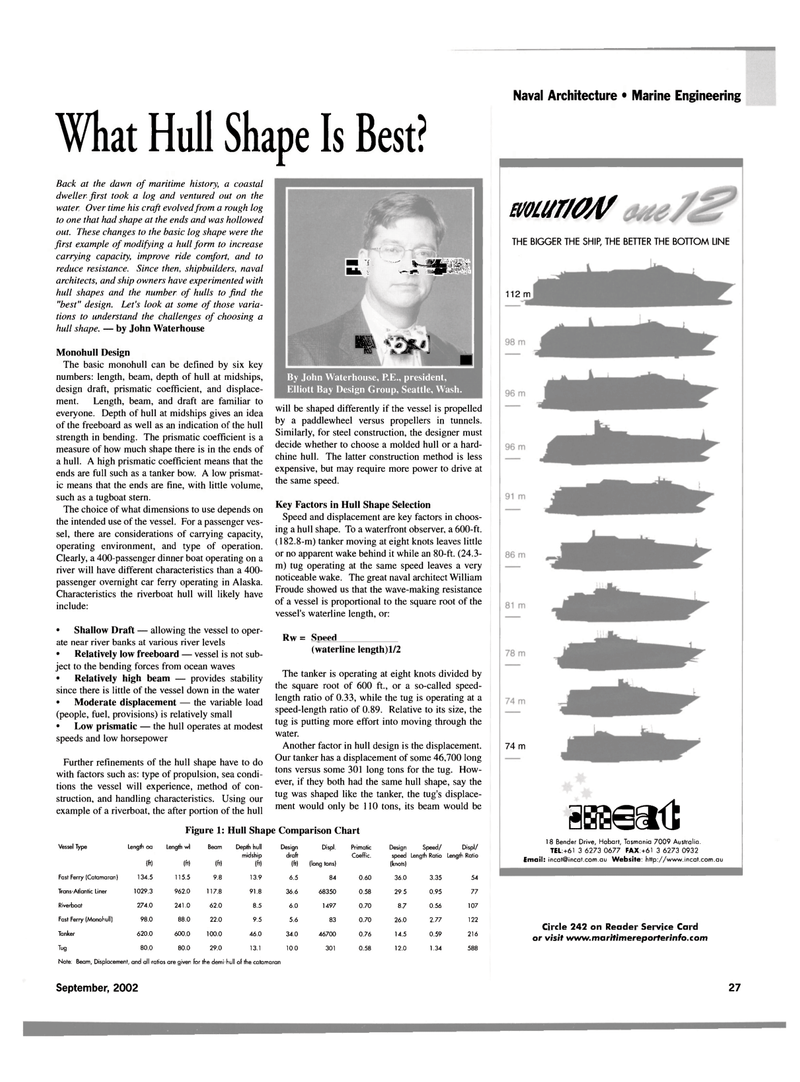
Page 27: of Maritime Reporter Magazine (September 2002)
Read this page in Pdf, Flash or Html5 edition of September 2002 Maritime Reporter Magazine
What Hull Shape Is Best?
Naval Architecture • Marine Engineering
Back at the dawn of maritime history, a coastal dweller first took a log and ventured out on the water. Over time his craft evolved from a rough log to one that had shape at the ends and was hollowed out. These changes to the basic log shape were the first example of modifying a hull form to increase carrying capacity, improve ride comfort, and to reduce resistance. Since then, shipbuilders, naval architects, and ship owners have experimented with hull shapes and the number of hulls to find the "best" design. Let's look at some of those varia- tions to understand the challenges of choosing a hull shape. — by John Waterhouse
Monohull Design
The basic monohull can be defined by six key numbers: length, beam, depth of hull at midships, design draft, prismatic coefficient, and displace- ment. Length, beam, and draft are familiar to everyone. Depth of hull at midships gives an idea of the freeboard as well as an indication of the hull strength in bending. The prismatic coefficient is a measure of how much shape there is in the ends of a hull. A high prismatic coefficient means that the ends are full such as a tanker bow. A low prismat- ic means that the ends are fine, with little volume, such as a tugboat stern.
The choice of what dimensions to use depends on the intended use of the vessel. For a passenger ves- sel, there are considerations of carrying capacity, operating environment, and type of operation.
Clearly, a 400-passenger dinner boat operating on a river will have different characteristics than a 400- passenger overnight car ferry operating in Alaska.
Characteristics the riverboat hull will likely have include: • Shallow Draft — allowing the vessel to oper- ate near river banks at various river levels • Relatively low freeboard — vessel is not sub- ject to the bending forces from ocean waves • Relatively high beam — provides stability since there is little of the vessel down in the water • Moderate displacement — the variable load (people, fuel, provisions) is relatively small • Low prismatic — the hull operates at modest speeds and low horsepower
Further refinements of the hull shape have to do with factors such as: type of propulsion, sea condi- tions the vessel will experience, method of con- struction, and handling characteristics. Using our example of a riverboat, the after portion of the hull
BBII ' V 1' lii *
Mslfe ."*•. ..^m sjPffe'x ^JSL-
Wsjjk \ ^JLy]
B
By John Waterhouse, RE., president,
Elliott Bay Design Group, Seattle, Wash. will be shaped differently if the vessel is propelled by a paddlewheel versus propellers in tunnels.
Similarly, for steel construction, the designer must decide whether to choose a molded hull or a hard- chine hull. The latter construction method is less expensive, but may require more power to drive at the same speed.
Key Factors in Hull Shape Selection
Speed and displacement are key factors in choos- ing a hull shape. To a waterfront observer, a 600-ft. (182.8-m) tanker moving at eight knots leaves little or no apparent wake behind it while an 80-ft. (24.3- m) tug operating at the same speed leaves a very noticeable wake. The great naval architect William
Froude showed us that the wave-making resistance of a vessel is proportional to the square root of the vessel's waterline length, or:
Rw = Speed (waterline length)l/2
The tanker is operating at eight knots divided by the square root of 600 ft., or a so-called speed- length ratio of 0.33, while the tug is operating at a speed-length ratio of 0.89. Relative to its size, the tug is putting more effort into moving through the water.
Another factor in hull design is the displacement.
Our tanker has a displacement of some 46,700 long tons versus some 301 long tons for the tug. How- ever, if they both had the same hull shape, say the tug was shaped like the tanker, the tug's displace- ment would only be 110 tons, its beam would be
Figure 1: Hull Shape Comparison Chart
Vessel Type Length oa Length wl Beam Depth hull Design Displ. Primatic Design Speed/ Displ/ midship draft Coeffic. speed Length Ratio Length Ratio (ft) (ft] (ft) (ft) (ft) (long tons) (knots)
Fast Ferry (Catamaran) 134.5 115.5 9.8 13.9 6.5 84 0.60 36.0 3.35 54
Trans-Atlantic Liner 1029.3 962.0 117.8 91.8 36.6 68350 0.58 29.5 0.95 77
Riverboat 274.0 241.0 62.0 8.5 6.0 1497 0.70 8.7 0.56 107
Fast Ferry (Monohull) 98.0 88.0 22.0 9.5 5.6 83 0.70 26.0 2.77 122
Tanker 620.0 600.0 100.0 46.0 34.0 46700 0.76 14.5 0.59 216
Tug 80.0 80.0 29.0 13.1 10.0 301 0.58 12.0 1.34 588
EMUT/CW
THE BIGGER THE SHIP, THE BETTER THE BOTTOM LINE 112 m 74 m mema 18 Bender Drive, Hobart, Tasmania 7009 Australia.
TEL+61 3 6273 0677 FAX:+61 3 6273 0932
Email: [email protected] Website: http://www.incat.com.au
Circle 242 on Reader Service Card or visit vwvw.mar/f/mereporfer/nfo.com
Note: Beam, Displacement, and all ratios are given for the demi-hull of the catamaran
September, 2002 27

 26
26

 28
28
